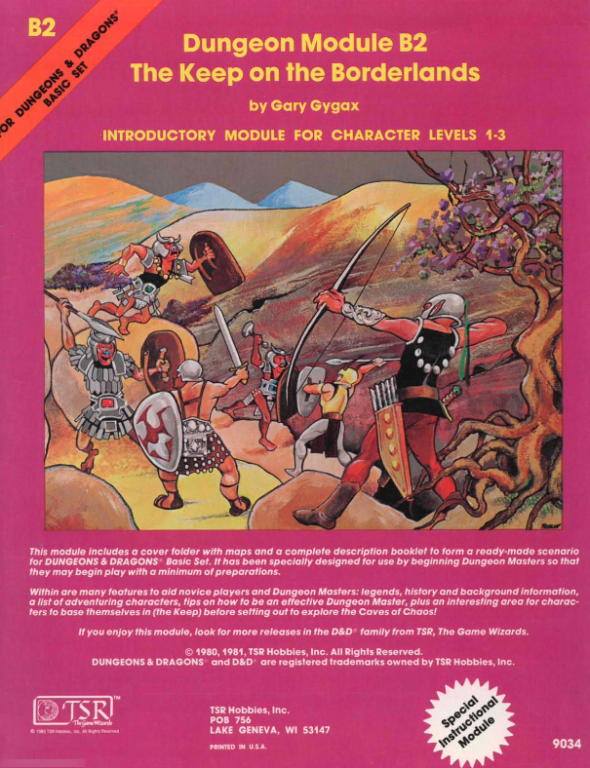
B2: The Keep on the Borderlands, Part Two
I’m not going to summarize the history and purpose of the venerable module know as “The Keep on the Borderlands” again. You can check out my previous article on this topic for that information. Instead, I’m going to dive into the section entitled “Tips to the Players” on page 25 (out of 26) of the module.
Tips to the Players
First off, this is a horrible place to put player tips. It’s after the adventure. A player that’s picked up this module and wants to play it without spoilers probably stopped reading the text somewhere around page 2 where it explicitly tells the players to stop reading. There is no mention of reference of this section in the introductory text, so there’s no way for a player to find this section prior to playing.
My guess is that TSR needed some “filler text” to get rid of some whitespace at the end of the book. Someone put together these brief tips and dropped them into the whitespace. I could be wrong. I could be right. I don’t know. Regardless of the cause of placing player tips at the back, it’s not a good area to drop this kind of advice.
The section is broken into an introductory paragraph followed by five brief paragraphs of actual advice, so let’s dive into them!
Organized and Cooperative
The advice given in this paragraph is spot on and still applies to this day. The “organized” section of this piece of advice basically boils down to “know your character and be ready to respond.” The DM can’t know everything about every ability of every character. They have enough to worry about on their side of the screen. This means you, as the player, need to know your character well enough to be able to quickly answer questions like, “Does anyone have [insert ability here]?” If you need to glance at your sheet to determine your answer, that’s fine, but know where on the character sheet that information can be found.
The cooperative part of this section leverages the phrase “… a variety of alignments and classes.” This is a fairly narrow perspective of the differences between characters (and people in general). This shows how focused that game was on alignment and class choice back then. I’m glad we’ve moved on to incorporate more subtle aspects of characters in modern gaming, but that’s probably a different post. The point of this paragraph is that the players need to have their characters work together in a tight-knit team despite any differences the characters may have. If cooperation is not part of the party’s game play, then this will, “… cause delays, attract monsters, and often result in the deaths of some or all of the members.” This closing statement is still valid and very true for modern D&D.
DM Rulings
This paragraph is worded a bit too harshly for my tastes. It basically implies that players can be whiny and disruptive if they disagree with the DM. The advice is solid, but I don’t like the wording used. Let’s update it a bit, shall we? Here goes.
The DM is the final arbiter of rules and rules conflicts, but the DM should welcome your reasonable input and ideas while considering the final ruling. If a player disagrees with the ruling, then disruptive and abusive behavior should be avoided. The player should accept the final ruling and move on. If the final ruling is egregious, unsafe, or harmful, the player always has the option of quietly stepping away from the game or not returning to the game with the DM at the next session. Being disruptive at the table over a rules disagreement drains the fun for everyone, even those not involved in the disagreement.
Planning
This paragraph is equipment-focused, which is fine, but it’s the final sentence that really stands out to me. The closing of the paragraph says, “Plans should be considered for encountering monsters and casting spells.” I wish there were more advice in this vein, so I’m going to expand that statement.
The PCs should decide a watch order while resting and a marching order while moving across open land and through dungeons. This will assist the DM in running a smooth adventure, especially when encounters occur. The players should also be aware of all abilities of all characters, but they don’t have to have everything memorized. Just know that the wizard has low hit points, but can cast powerful spells. Know that the cleric can heal and that the fighter has the best armor class in the group. These key points can help keep everyone as safe as possible when encounters happen.
Knowing which spells are available to the party at a given time is also key. The spell casters should also know when it’s appropriate to use certain spells. Fireballing two goblins that are surrounded by the rest of the party probably isn’t the wisest choice, but casting Magic Missile at the goblins would most likely work out well. Clerics should also know when to apply their limited healing. Casting powerful healing spells on someone that is only down a few hit points would be a waste, but that same spell could get the almost-dead fighter back into the fray in a moment’s notice.
Caution
I love this paragraph and it still stands true today without modification, with one exception. The exception is that dangers can also come from within the party by way of lying and trickery. That might still be true with some groups, but not in groups I like to play with. The party is a team literally fighting for survival. Lying, trickery, backstabbing, and duplicity from within the party will guarantee failure, and possibly character death. Avoid that at all costs.
The remainder of the paragraph, though, is strong and well stated. Basically, it says that caution is necessary. Don’t charge forward with preparation or be ready to meet doom. It also says that too much caution is as dangerous as too little. Bold and quick action is sometimes necessary before all is lost.
Thinking
This is a good closing paragraph. It tells the players to think through problems and that their minds, wits, and imaginations will carry them further through the game than luck or brute force. The last sentence says, “The challenge of thinking is a great deal of the fun of the game.”
I couldn’t agree more with that last statement.
















